Overview
As centuries past have served to define advances in technology, the year 2000 has seen a decided shift in the approach taken toward film sound recording. Analog tape is gone, along with the traditional concept of mixers and recorders functioning as separate devices. Gone as well are mixers that actually have a signal path and control section that carries audio, replaced instead by DSP technology. Similar to larger consoles used in music recording, broadcast and live sound, portable film mixers now function primarily as control surfaces, with the actual audio section being part of a separate I/O rack, or in the recorder itself. And with the proliferation of AES, TDIF, and DANTE interfaces, in many cases, there is very little analog audio to be found at all.
The advantages of this approach for film sound recording are significant. No longer do consoles require a dedicated channel strip, with numerous controls and associated components for signal processing functions such as EQ, filtering, and limiting. All signal routing (buss assigns, solo, panning) are similarly handled by DSP. All that is required of each input is a chip set that allows these various functions to be controlled by an external signal that is tied to a primary data buss. And since it isn’t always necessary to have all of those controls individually accessible for every input channel, space requirements (as well as cost) can be reduced by using a common set of controls to address the individual channels via a selector switch. While some sound mixers prefer the dedicated controls that are the hallmark of analog mixers, it can’t be denied that the DSP approach provides for a range of features that would be difficult to implement in a compact footprint. Additionally, the ability to save primary settings is a huge plus when changing setups.
As noted in our previous installment, one of the first portable mixers for film use that adopted this approach was the Zaxcom Cameo, introduced in late 1999. Since that time, there has been a steady stream of developments by Zaxcom, Sound Devices, Sonosax, Allen & Heath, Zoom, and other manufacturers, all of which take a similar approach when it comes to treating the mixer as an adjunct control device to the recorder.
Here is a look at what is currently on the market, and some thoughts about where it might be headed:
Aaton Cantaress
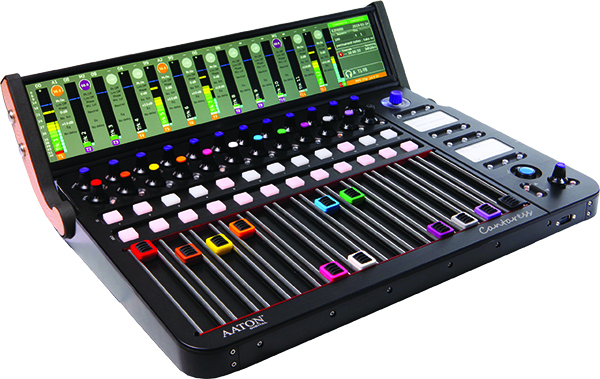
Conceived by Jean Pierre Beauviala, the Aaton Cantaress is a 12-input mixer designed to work in conjunction with the Aaton Cantar X3 and Cantar Mini recorders. In a departure from the approach used on many other mixer surfaces, the Cantaress employs magnetic faders, which help to keep dirt and debris from the fader mechanism and resistive element. Additionally, the connection to the recorders is handled over an Ethernet connection as opposed to a USB port. Similar to the Zaxcom Mix-16, it also sports dedicated LED metering for each input channel, which provides the user with a ready display of levels. Power (12-17 VDC) is provided separately via an XLR-4 connector.
Sound Devices CL-9
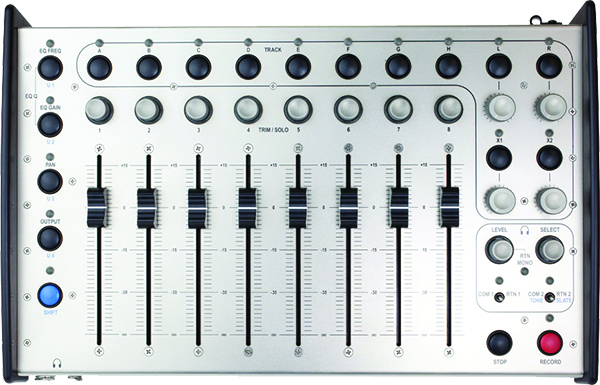
After the Zaxcom Cameo, one of the second entries in the realm of mixing surfaces was the (now discontinued) CL-9, introduced by Sound Devices, and designed as a dedicated mixing surface for the 788T series recorders. Connected to the 788 via a USB cable, the CL-9 included many features found on traditional analog mixers, including 100mm linear faders, dedicated gain trim controls, two aux sends, parametric EQ, and two bi-directional boom comm channels. The power was provided via the USB port on the recorder, and the EQ functions mimicked the EQ features already included on the 788.
Zaxcom Mix-16
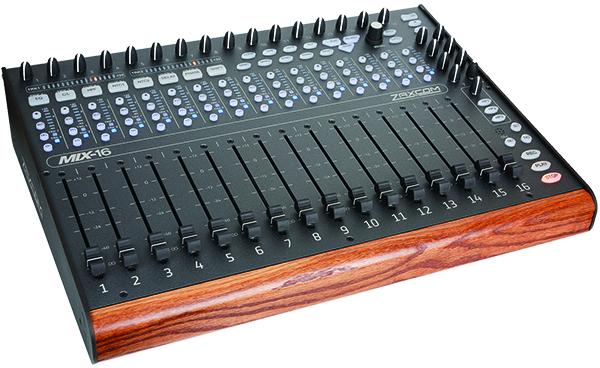
Introduced in 2018, the Zaxcom Mix-16 is a 16-channel mixing surface intended to interface with the Deva 16 recorder. With linear faders, dedicated input channel metering, buss assignment, PFL and gain trim controls, the Mix-16 provides many features found on traditional analog mixers, but also has some capabilities that can’t be found on analog consoles, such as individual input channel delay, grouping functions, plus the ability to control the primary functions of the Deva 16 recorder. Additionally, provision is made to control the gain of Zaxcom radio mic systems via the Zaxnet control interface, enabling the mixer to instantaneously control transmitter gains for the corresponding inputs. Power for the mixer is supplied by a separate power source of 8-18 VDC.
Sound Devices CL-6

While not really intended as a fully featured mixing surface, the CL-6 functions as an expansion device for the 664 and 668 series recorders, allowing for additional input for control capabilities for inputs seven to twelve. Equipped with rotary faders, it allows the user to control the input gain with dedicated controls, as opposed to small trim knobs on the recorder.
Sound Devices CL-12
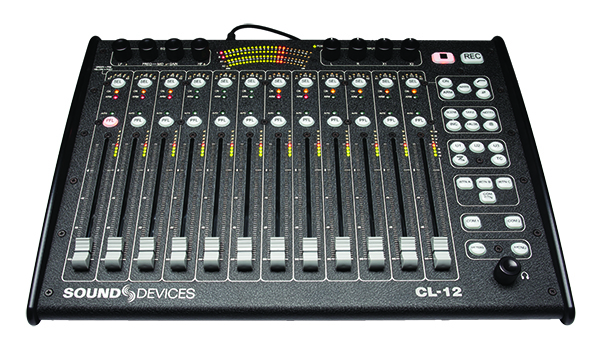
Conceptually similar to the Sound Devices CL-9, the CL-12 mixer is intended as an adjunct to the Sound Devices 6 series recorders, and likewise functions primarily as a control surface. The mixer provides independent fader control for twelve inputs, giving the user control of level, input gain, phase, HP filters (and when used with the 688 recorder), 3-band equalization. It also provides control of recorder functions, along with monitoring and talkback communication functions for two boom operators. When used with a 688 recorder equipped with the SL-6 SuperSlot wireless receiver option, it is also possible to control the features of the wireless receivers. While the mixer interfaces with all the 6 series recorders via the USB port, power needs to be supplied externally for 633 and 664 series recorders.
Sonosax SX-ST
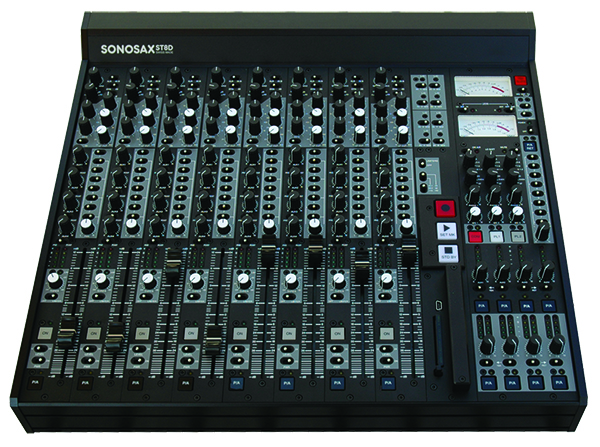
Although the Sonosax SX-ST mixer is technically not a mixer surface, the inclusion of an onboard recorder as part of analog mixer is unique approach to integrated mixer/recorder products. The recording system can be provided as part of the standard SX-ST mixer line, and can be ordered with eight to twelve inputs. The SX-ST mixer utilizes eight program mix busses, which can be assigned to both the recorder and the analog or digital outputs. The input channels are equipped with separate limiters, 3-band equalization, and direct outs (channel inserts are optional). It can be powered via internal D batteries, or an external 10.5 VDC to 20 VDC power source. Prized by many production mixers for its sonic quality, the Sonosax is the only mixer/recorder combo to provide an analog mixer with a digital recorder.
Zoom LiveTrack L-12 Mixer/Recorder
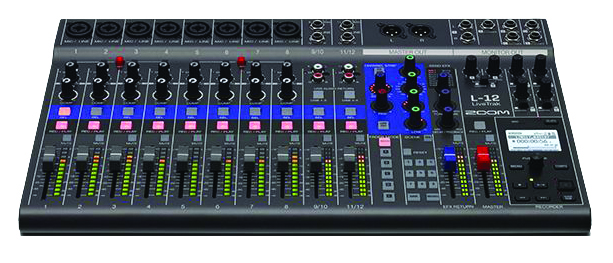
While the Zoom LiveTrack L-12 would not typically be found on a film set (due to lack of timecode, Scene/Take/Note metadata functions, and other limitations), I am including it here as an example of how far this technology has come. Sporting twelve tracks, twelve inputs, and 24-bit 96 kHz recording capability, along with basic equalization, at $600 street price, it certainly is something to be reckoned with. Thirty years ago, one would have needed at least a one-inch 8-track recorder and separate mixer to duplicate the basic functions that this unit provides (of course, mic preamps and other features may likely not be up to the same standards one would expect). Still, it’s hard to ignore what can be accomplished at this price point.
The Future
So, in the span of about six decades, we have gone from analog mixing consoles equipped with large rotary faders, requiring significant amounts of power (and with very few features), down to small digital control surfaces that have virtually no analog signal path, whose primarily function is as an outboard control for the recorder. While the concept of a standalone mixer has not completely disappeared from the landscape (especially for larger channel counts), it is clear that when it comes to portable systems destined for location shooting of film and TV productions, integrated mixer/recorder systems will continue to be the primary path of development.
With the ability now to integrate wireless mic systems into the control path, we will undoubtedly see an expansion of the features related to RF systems (for example, the ability to load a full set of channel presets for both transmitters and receivers, and have real-time monitoring of the system as part of the control surface). As the trend toward miniaturization continues, the primary limitation will likely be that of the human interface, not technology itself. A sound mixer still has only ten fingers and two feet, so until the “direct brain interface” comes along, where one can control a mixer by thought, we are probably close to the limit as to how many channels can be packed into a given footprint. But I could be wrong…
©2019 by Scott D. Smith CAS, all rights reserved.